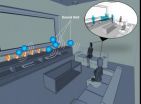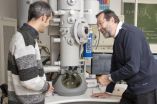(Press-News.org) Daejeon, Republic of Korea, November 5th, 2012—Watching a 3 dimensional (3D) film at home can be just as real and fun as going to a movie theater. Professor Yang-Hann Kim and Research Professor Jung-Woo Choi from the Department of Mechanical Engineering, KAIST, have succeeded in building an audio rendering system that will considerably improve the current 3D audio effects technology.
3D audio effects can be produced by stereo speakers, surround-sound speakers, speaker-arrays, or headphones, which essentially give an illusion to listeners that sounds are being produced in the 3D space around them. The effects are the result of manipulating the listener's sound perception through the placement of virtual sound sources in the 3D space to alter the way the sound is played. In a 3D audio and acoustic environment, listeners can recognize the location, distance, and direction of sound sources including behind, above, or below the listeners, thereby providing them with a more interactive, engaging, and real-time experience when enjoying movies, games, or music.
Professor Kim's team completed a set of simple integral equations to create a virtual sound source inside of an area enclosed with loudspeakers (deployed in linear or circular shapes). So far, the placement of a virtual sound source within the array of loudspeakers and the reproduction of sound field from them are considered "physically unlikely," and hence they have been approached in an approximated form. This is because the sound field reproduced from the internal virtual source should satisfy an inhomogeneous wave equation, a numerical computational method applied in acoustics engineering to create a target sound field where a sound source does not exist.
The research team proposed a theoretical basis for the solution, and this research appeared in the September 2012 issue of IEEE Transactions on Audio, Speech, and Language Processing published by the IEEE Signal Processing Society. (http://ieeexplore.ieee.org/stamp/stamp.jsp?arnumber=06175109)
Based on the integral equations, Professor Kim and his team developed a loudspeakers array system that is composed of a large number of loudspeakers, ranging from 24, 34, 50, and up to 64 speakers and created a virtual sound source, "Virtual Sound Ball," within the array system. (Youtube link for virtual sound ball: http://www.youtube.com/watch?v=NS4mn0_bLmw)
Professor Kim explained the new technology, "We used many loudspeakers in order to build multipole virtual sound sources that would give a listener more freedom to move around without losing an auditory illusion of target sound fields perceived by the listener. Unlike the common example of sound field reproduction from a virtual source located outside the loudspeakers array system, our method, putting the sound source inside the speakers system, will offer not only a very high quality 3D sound, but also an individualized, customized optimal sound that can be controlled and adjusted based on the needs of each listener."
When a virtual sound ball is located inside the array of loudspeakers, the auditory image produced from the ball (source) lies right in front of, next to, or behind the listener. In other words, when the listener hears a classical music concert from an audio set, the sound field reproduced from the virtual sound ball makes the listener feel all the more like sitting in an actual concert hall.
Professor Yang-Hann Kim and Jung-Woo Choi established a controllable sound field within a restricted area based on the loudspeaker setup and formed multipole sound balls by focusing and localizing acoustical energy both in space and time while minimizing external radiation. Sound balls can be moved around as needed by a listener and controlled through software interface, a device used for the adjustment of spatial attributes of sound to create 3D audio effects.
The research team developed a "spatial equalizer" that allows a smart phone or tablet PC, via wi-fi, to control the sound field reproduced from the sound ball just the way a balance knob in a stereo audio system works—a listener controls the balancer until he/she finds the perfect sound.
"We expect that this technology, which is ready for an immediate translation into commercial products, will upgrade our home and personal audio system to the level of professional settings," said Professor Jung-Woo Choi.
INFORMATION:
This research is supported by the Korea Electrics Technology Institute (KETI).
For further inquiries, please contact Professor Yang-Hann Kim, Department of Mechanical Engineering, KAIST, at +82-42-350-3025, +82-10-5403-1008, or yanghann@kaist.ac.kr.
Build your own home theater for full-blast entertainment with 'Virtual Sound Ball'
A KAIST research team developed a powerful audio rendering technology that reproduces a desired sound field 'more clearly and accurately' to an original sound source by establishing an array system of loudspeakers and software interface
2012-11-05
ELSE PRESS RELEASES FROM THIS DATE:
Sensors for the real world
2012-11-05
Over the last decade there has been an increased interest in developing resonators for gravitmetric sensing; however, the sensors' response to variations in temperature has prevented them from being used outside the laboratory. New sensors developed by researchers at the University of Cambridge negate the effects of temperature so that they may be used in industries including health care, telecommunications and environmental monitoring.
Sensors built from high frequency bulk acoustic wave (BAW) resonators consist of a piezoelectric layer sandwiched between two electrodes, ...
Electron microscopes with a twist
2012-11-05
This press release is available in German.
Nowadays, electron microscopes are an essential tool, especially in the field of materials science. At TU Vienna, electron beams are being created that possess an inner rotation, similarly to a tornado. These "vortex beams" cannot only be used to display objects, but to investigate material-specific properties - with precision on a nanometer scale. A new breakthrough in research now allows scientists to produce much more intense vortex beams than ever before.
Quantum Tornado: the Electron as a Wave
In a tornado, the individual ...
High-strength material advancements at Wayne State University may lead to new, life-saving steel
2012-11-05
DETROIT— There has been great advancements in the development of the high-strength steel and the need for additional enhancements continue to grow. Various industries have a need for structural components that are lighter and stronger, improve energy efficiencies, reduce emissions and pollution increase safety and cost less to produce, particularly in the automotive industry.
A group of researchers in Wayne State University's College of Engineering have been working to create advanced materials with high-yield strength, fracture toughness and ductility. Their efforts ...
Duke Medicine news -- Some heart patients may respond differently to anti-platelet drugs
2012-11-05
DURHAM, N.C. – The cause of heart attacks or strokes among some patients treated with anti-platelet drugs may be different than for patients who have undergone surgical procedures to restore blood flow, according to researchers at Duke Medicine.
The finding -- reported Nov. 4, 2012, at the American Heart Association's Scientific Sessions annual meeting and published in the Journal of the American Medical Association – provides new insights into a subset of heart patients with acute coronary syndromes (ACS) whose risk for cardiovascular events remained unchanged despite ...
Cockatoo 'can make its own tools'
2012-11-05
A cockatoo from a species not known to use tools in the wild has been observed spontaneously making and using tools for reaching food and other objects.
A Goffin's cockatoo called 'Figaro', that has been reared in captivity and lives near Vienna, used his powerful beak to cut long splinters out of wooden beams in its aviary, or twigs out of a branch, to reach and rake in objects out of its reach. Researchers from the Universities of Oxford and Vienna filmed Figaro making and using these tools.
How the bird discovered how to make and use tools is unclear but shows how ...
High fever and evidence of a virus? Caution, it still may be Kawasaki disease
2012-11-05
Clinicians should take caution when diagnosing a child who has a high fever and whose tests show evidence of adenovirus, and not assume the virus is responsible for Kawasaki-like symptoms. According to a new study from Nationwide Children's Hospital appearing in Clinical Infectious Diseases, adenovirus detection is not uncommon among children with Kawasaki disease.
Kawasaki disease is a rare but serious condition in children that involves inflammation of the blood vessels, specifically the heart vessels that supply the heart tissue or coronary arteries. It is the most ...
Scientists identify insect-repelling compounds in Jatropha
2012-11-05
This press release is available in Spanish.
A tip about a folk remedy plant used in India and Africa to ward off bugs has led to the discovery of insect-repelling compounds.
U.S. Department of Agriculture (USDA) scientists have identified components of Jatropha curcas seed oil that are responsible for mosquito repellency. Researchers at the Agricultural Research Service (ARS) Natural Products Utilization Research Unit (NPURU) in Oxford, Miss., often find effective plant-derived compounds to deter insects by gathering plants in the wild and investigating those used ...
Loser-pays-all rule in criminal cases could work for wealthy defendants
2012-11-05
CHAMPAIGN, Ill. — Adopting a loser-pays-all rule for criminal litigation would likely be feasible only if the rule applied to defendants who are wealthy, says a study from a University of Illinois law professor.
Nuno Garoupa, the H. Ross and Helen Workman Research Scholar in the College of Law, says a loser-pays-all rule could deter some crime when it's applied to either a corporation or an individual with deep pockets. But when defendants are not wealthy, such cost-shifting would be "wholly inappropriate," he says.
"On the defendant's side, the problem is that a significant ...
Checklists in the operating room: More safety for patients
2012-11-05
The use of the World Health Organization's Surgical Safety Checklist in the operating room considerably lowers the risks of surgery. This is the conclusion of Axel Fudickar and co-authors in their article in Issue 42 of Deutsches Ärzteblatt International (Dtsch Arztebl Int 2012; 109(42): 695).
The most common errors in safety-related behavior in the operating room are attributable to inadequate communication and teamwork. The Surgical Safety Checklist, which was introduced by the World Health Organization in 2007, has the main effect of improving commmunication of the ...
2001-2002 drought helped propel mountain pine beetle epidemic, says CU study
2012-11-05
A new University of Colorado Boulder study shows for the first time that episodes of reduced precipitation in the southern Rocky Mountains, especially during the 2001-02 drought, greatly accelerated development of the mountain pine beetle epidemic.
The study, the first ever to chart the evolution of the current pine beetle epidemic in the southern Rocky Mountains, compared patterns of beetle outbreak in the two primary host species, the ponderosa pine and lodgepole pine, said CU-Boulder doctoral student Teresa Chapman. The current mountain pine beetle outbreak in the ...
LAST 30 PRESS RELEASES:
Jeonbuk National University study shows positive parenting can protect adolescents against self-harm
Surface-engineered ZnO nanocrystals to tackle perfluoroalkyl substance contamination
This new understanding of T cell receptors may improve cancer immunotherapies
A new fossil face sheds light on early migrations of ancient human ancestor
A new immunotherapy approach could work for many types of cancer
A new way to diagnose deadly lung infections and save lives
40 percent of MRI signals do not correspond to actual brain activity
How brain-inspired algorithms could drive down AI energy costs
Gum disease may be linked to plaque buildup in arteries, higher risk of major CVD events
Contrails are a major driver of aviation’s climate impact
Structure of dopamine-releasing neurons relates to the type of circuits they form for smell-processing
Reducing social isolation protects the brain in later life
Keeping the heart healthy increases longevity even after cancer
Young adults commonly mix cannabis with nicotine and tobacco
Comprehensive review illuminates tau protein's dual nature in brain health, disease, and emerging psychiatric connections
Book prepares K-12 leaders for the next public health crisis
Storms in the Southern Ocean mitigates global warming
Seals on the move: Research reveals key data for offshore development and international ecology
Sports injuries sustained during your period might be more severe
World's first successful 2 Tbit/s free-space optical communication using small optical terminals mountable on satellites and HAPS
Can intimate relationships affect your heart? New study says ‘yes’
Scalable and healable gradient textiles for multi‑scenario radiative cooling via bicomponent blow spinning
Research shows informed traders never let a good climate crisis go to waste
Intelligent XGBoost framework enhances asphalt pavement skid resistance assessment
Dual-function biomaterials for postoperative osteosarcoma: Tumor suppression and bone regeneration
New framework reveals where transport emissions concentrate in Singapore
NTP-enhanced lattice oxygen activation in Ce-Co catalysts for low-temperature soot combustion
Synergistic interface engineering in Cu-Zn-Ce catalysts for efficient CO2 hydrogenation to methanol
COVID-19 leaves a lasting mark on the human brain
Scientists use ultrasound to soften and treat cancer tumors without damaging healthy tissue
[Press-News.org] Build your own home theater for full-blast entertainment with 'Virtual Sound Ball'A KAIST research team developed a powerful audio rendering technology that reproduces a desired sound field 'more clearly and accurately' to an original sound source by establishing an array system of loudspeakers and software interface



